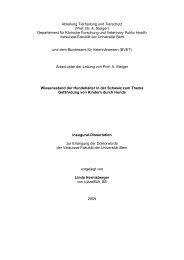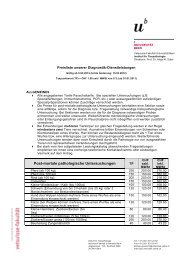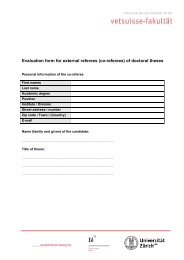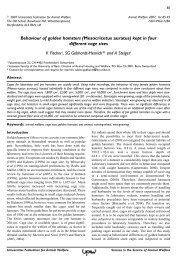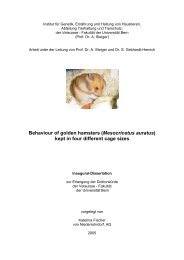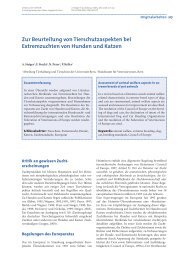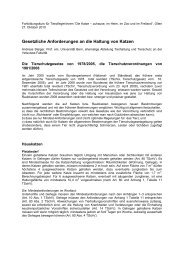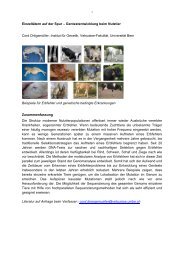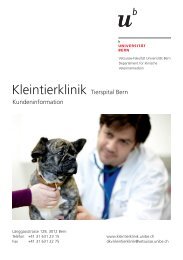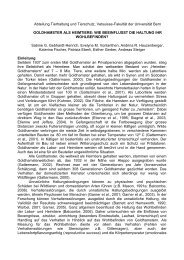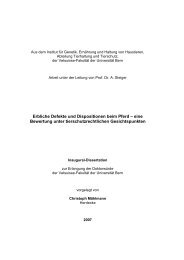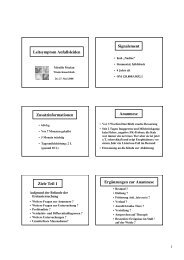Lifespan and Causes of Death in the Irish Wolfhound - Vetsuisse ...
Lifespan and Causes of Death in the Irish Wolfhound - Vetsuisse ...
Lifespan and Causes of Death in the Irish Wolfhound - Vetsuisse ...
You also want an ePaper? Increase the reach of your titles
YUMPU automatically turns print PDFs into web optimized ePapers that Google loves.
first-generation progeny. The broadness <strong>of</strong> <strong>the</strong> genogram thus gives an impression <strong>of</strong><br />
<strong>the</strong> effective breed<strong>in</strong>g population size at a given time.<br />
5 4<br />
3<br />
2<br />
1<br />
6<br />
Masked<br />
Inbreed<strong>in</strong>g<br />
Exponential<br />
Growth<br />
WW 2<br />
1939-45<br />
Interwar<br />
years<br />
WW 1<br />
1914-18<br />
Consolidation<br />
ca. 1890-1914<br />
1860: Initiation<br />
<strong>of</strong> Modern<br />
Breed<strong>in</strong>g<br />
Fig. 7.1: Typical genogram <strong>of</strong> an <strong>Irish</strong> <strong>Wolfhound</strong> born <strong>in</strong> 2000 (field <strong>in</strong> <strong>the</strong> far left),<br />
illustrat<strong>in</strong>g <strong>the</strong> occurrence <strong>of</strong> several genetic bottlenecks dur<strong>in</strong>g <strong>the</strong> history <strong>of</strong> <strong>the</strong><br />
population. The numbers <strong>in</strong> <strong>the</strong> figure refer to <strong>the</strong> occurrences described <strong>in</strong> table 7.1<br />
above. Compare this graph to fig. 6.3 <strong>and</strong> 6.4<br />
Note that <strong>the</strong> third <strong>and</strong> fourth genetic bottleneck do not appear as separate<br />
occurrences <strong>in</strong> this graph due to <strong>the</strong>ir closeness <strong>in</strong> time. The studied <strong>in</strong>dividual is<br />
subject to an average level <strong>of</strong> <strong>in</strong>breed<strong>in</strong>g (COI(5)=0.0078; COI(10)=0.1120;<br />
COI(20)=0.2707; Meuwissen's Inbreed<strong>in</strong>g Coefficient = 0.3470).<br />
7.2.2 Inbreed<strong>in</strong>g <strong>and</strong> <strong>Lifespan</strong><br />
7.2.2.1 Mechanisms <strong>of</strong> Inbreed<strong>in</strong>g Depression<br />
Inbreed<strong>in</strong>g depression cannot occur if gene effects are purely additive – some<br />
degree <strong>of</strong> dom<strong>in</strong>ance <strong>and</strong>/or epistatic <strong>in</strong>teraction between genes is necessary.<br />
Currently, <strong>the</strong>re are two ma<strong>in</strong> <strong>the</strong>ories on <strong>the</strong> genetic mechanisms underly<strong>in</strong>g<br />
<strong>in</strong>breed<strong>in</strong>g depression: The partial dom<strong>in</strong>ance model <strong>and</strong> <strong>the</strong> overdom<strong>in</strong>ance model<br />
(Charlesworth <strong>and</strong> Charlesworth 1987).<br />
The partial dom<strong>in</strong>ance model <strong>of</strong> <strong>in</strong>breed<strong>in</strong>g depression postulates that <strong>in</strong>breed<strong>in</strong>g<br />
depression is caused by <strong>the</strong> accumulation <strong>of</strong> recessive deleterious alleles that can<br />
occur as <strong>the</strong> degree <strong>of</strong> homozygosis <strong>in</strong>creases. This accumulation <strong>of</strong> recessive<br />
deleterious alleles ("genetic load") that are normally masked by dom<strong>in</strong>ance effects <strong>in</strong><br />
<strong>the</strong> heterozygous form results <strong>in</strong> a loss <strong>of</strong> fitness <strong>in</strong> <strong>the</strong> <strong>in</strong>bred population, which can<br />
be expected to be proportional to <strong>the</strong> degree <strong>of</strong> deleteriousness <strong>in</strong> <strong>the</strong> relevant<br />
alleles.<br />
97



